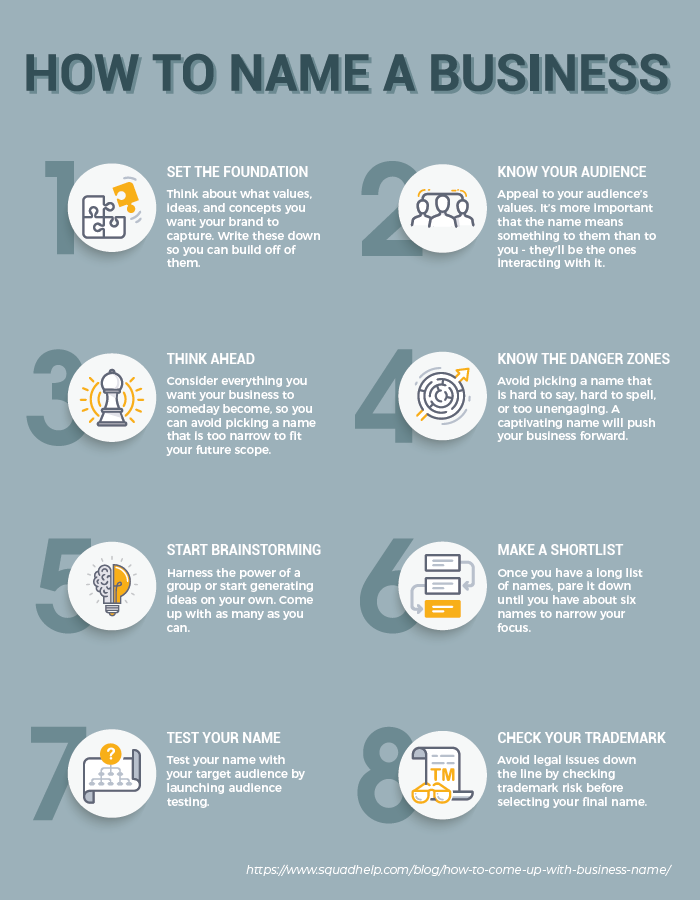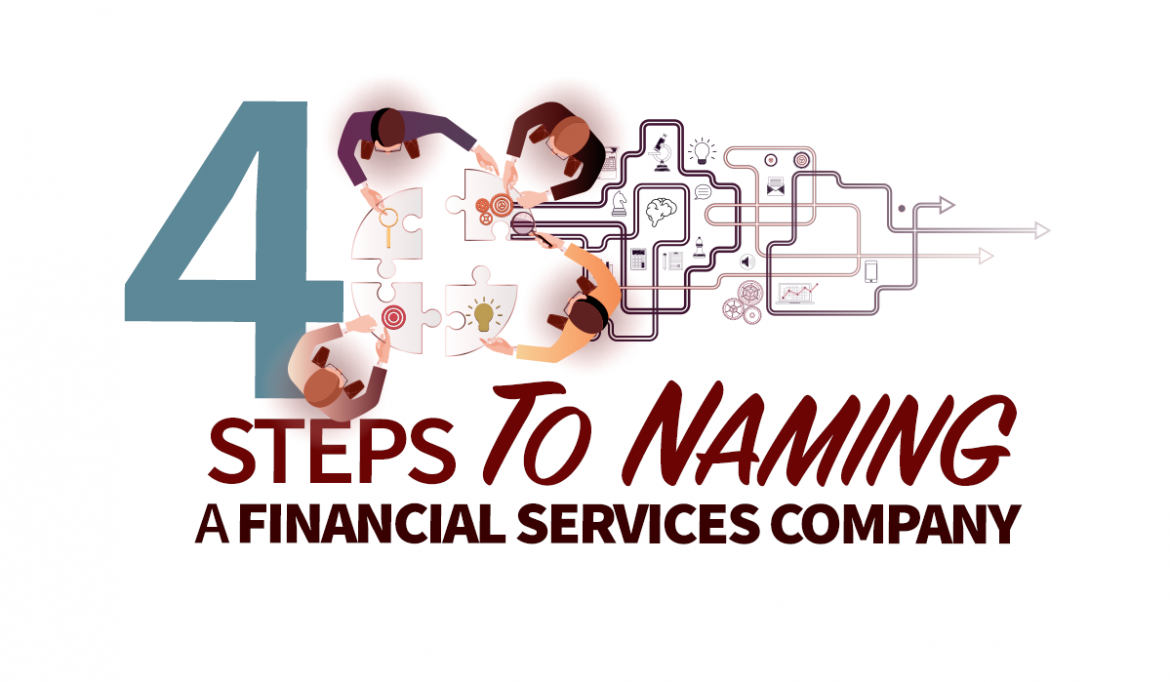Updated September 6, 2023, at 9:15 PM
Done right, naming a financial services company will be deeply personal and very telling. Potential customers will develop their own expectations based on the name of your business. Be aware that if it doesn’t sit well, they’ll probably go elsewhere.
Developing a name should start with high-level brainstorming and then drill down to specifics. Naming shouldn’t be done alone. If possible, bring in a variety of people. Include co-workers as well as those not associated
with the business but who know you personally for the brainstorming sessions. Your business associates will be polite, but you need your friends to tell you the truth! “On Time Deliveries” is only a good company name if you’re actually punctual.
A STRONG BUSINESS NAME WILL STAND OUT, BE MEMORABLE, AND IS EASILY SHARED
Now that you’ve got your brainstorming hat on, a few friends and colleagues to help, and a financial services company to name, it’s time to get to work.
Follow these four main steps to naming a financial services company.
Step #1: Brainstorm
Start with whatever big ideas come to mind. Think quickly and write everything down. Using a whiteboard or wall makes it easy to visualize and move things around. Pro tip: Post-it notes are great to use during this process.
Every word will help you get to a great result, even if you feel the word isn’t right or silly at the time. There are name generators online but without your personal input, the results most likely won’t reflect your personality.
Related: Shift into Marketing Gear: Tips for Committing to Your Marketing Strategy
Step #2: Drill Down
What do the words say about you? What jumps out that points back to your passions and motivations? Catchy names work if you’re Google or Amazon, but if you’re not in that arena pick a name that says something meaningful. As you narrow down ideas, your brand value proposition should start to emerge and mirror the concepts you’re choosing.

Be honest with yourself. By answering these questions,
you start to develop the part of your business name that
reflects who you are:
• What motivates you to do what you do?
• What personal values or customer values drive your brand?
• Why should people trust you?
• Is there a personal story you want to tie your name to?
Stay focused and on target. These questions will turn
into the part of your name that says what you do:
• What does your company do?
• Why are these services a benefit to your customer?
• What will make the customer comfortable?
• What will make the customer trusting?
• What will make the customer satisfied?
• Who is your ideal customer?
Step #3: Review
Look for patterns. Look for strong words. Group similar words and concepts together. Using Thesaurus.com to discover synonyms and antonyms can assist with generating a list of words to consider and keep you from including a negative word. Pro tip: This step is a great time to sort through those post-it notes.
Also, look for ethnic or geographic offenses—remember the Chevy Nova which in Spanish means “no go”? Any words that miss the mark should be put in a separate pile but don’t toss them. You may want to refer to that list to make sure one didn’t somehow end up back on the board.
Sort your list and eliminate the unnecessary. If the word feels wrong today, it’s going to feel worse later so toss it now. Trusting your gut feelings at this point will keep you on track. Consider these tips:
• Keep the words that reflect your company’s strengths
• Put in the discard pile any words and images you want to avoid
• Any word that is too hard to pronounce is best discarded
Be creative. There are no rules regarding your business name, so go ahead and be unique. Consider a combination of words that start as separate words but when combined correctly make a memorable and strong message. Bad Daddy Burgers would have been much worse had they chosen Daddy’s Bad Burgers.
Then, take your list of words and images and move them around. Play with ideas and messages until you find the names that accurately reflect your passion and intent.
Related: The Financial Professional’s Inbound Marketing Funnel [Infographic]
Step #4: Get Feedback
It’s possible to get too attached to the wrong name and miss the obvious (too funny, too negative), so take your top three choices and present them to an unbiased group.
If you need a wider group to help you in this step, consider an online crowdsourcing company. It costs you some money, but they can provide some outside input and help you land on target. Listen to all feedback and adjust your choices before making any final decisions.
Consider: Is your name in the CARE or the DON’T category?
Positive feedback will mean your name is:
- Contextual – makes sense for your brand
- Appealing – pleasant to say or hear
- Remarkable – memorable and sharable
- Evocative – clever and emotional
Negative feedback means the name is:
- Difficult – can’t spell or pronounce
- Obscure – people don’t “get it”
- Neutral – safe and mundane
- Taken – already in the marketplace
Final Tips for Naming Your Financial Services Company

1. Consider avoiding using your name or location.
You may want to see your name in lights but staying too close to home can limit your potential business growth. “Smith Shoe Shining of Mayberry” doesn’t leave much room for hats, handbags, or a running club when you’re ready to expand.
2. Avoid names that are hard to spell or pronounce.
Write out the name and say it out loud. Even consider what it might sound
or look like if shortened. Do you really think a collaborative site that shares what teachers are talking about wanted to promote stalkers with teacherstalk.com?
3. Conduct a thorough name search.
Do all that work and someone already owns it? If that’s the case, consider an offshoot that still conveys your message. Sometimes a financial services company name sounds great until you realize it feels right because you already heard it. Also, if your name is too close to a similar business,
the Secretary of State may stop you from registering it.
4. Check for domain availability.
Heading to GoDaddy is a good next step to determine availability and
cost. They can offer suggestions if your name isn’t available and can even incorporate your site’s email address and websites if you need it.
Keep in mind your domain extension can influence your search rankings and will help build brand recognition. Businesses typically use the “.com” extension, leaving the “.org” for the nonprofits and “.net” for networks.
5. Include your business structure.
Being a sole proprietor, an LLC, or an S corp will make a difference when you select your final name and if you plan to add “Inc.” to the end. Legalzoom can help explain and get you started if you need help.
Final Thought
The right message and tone will attract the right clients—decide if you want to blend in or stand out. Take the time, make the effort, and you’ll discover a business name that’s true to you.


